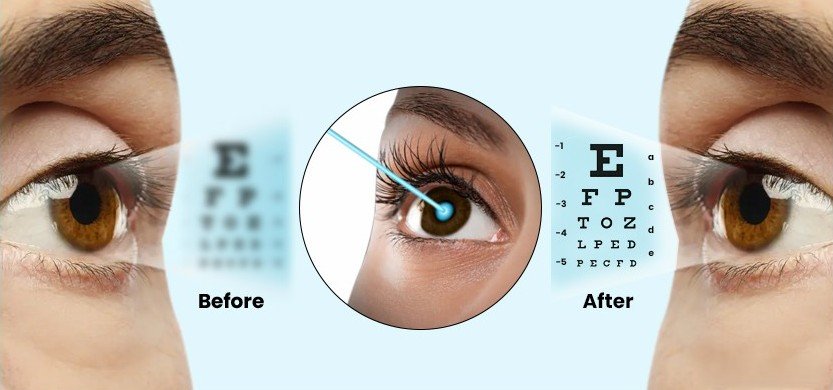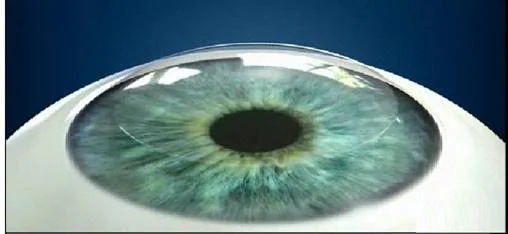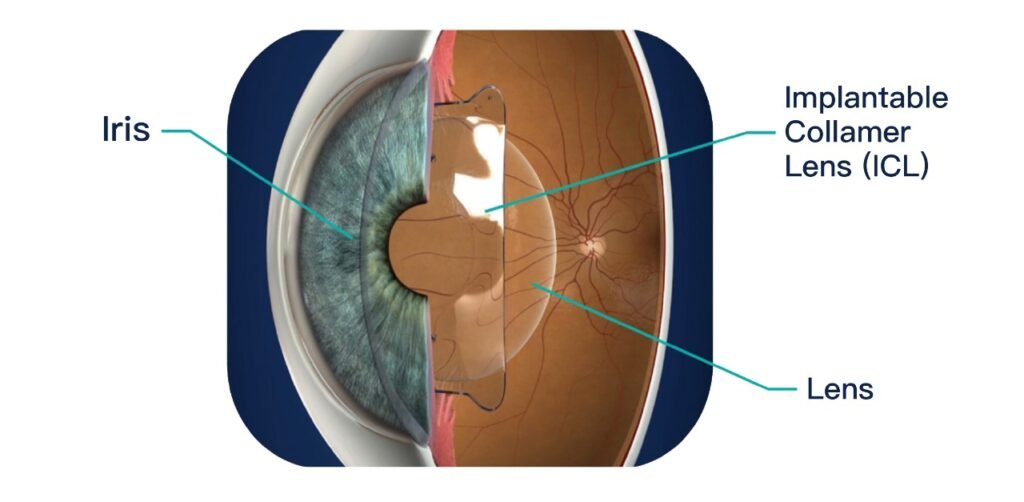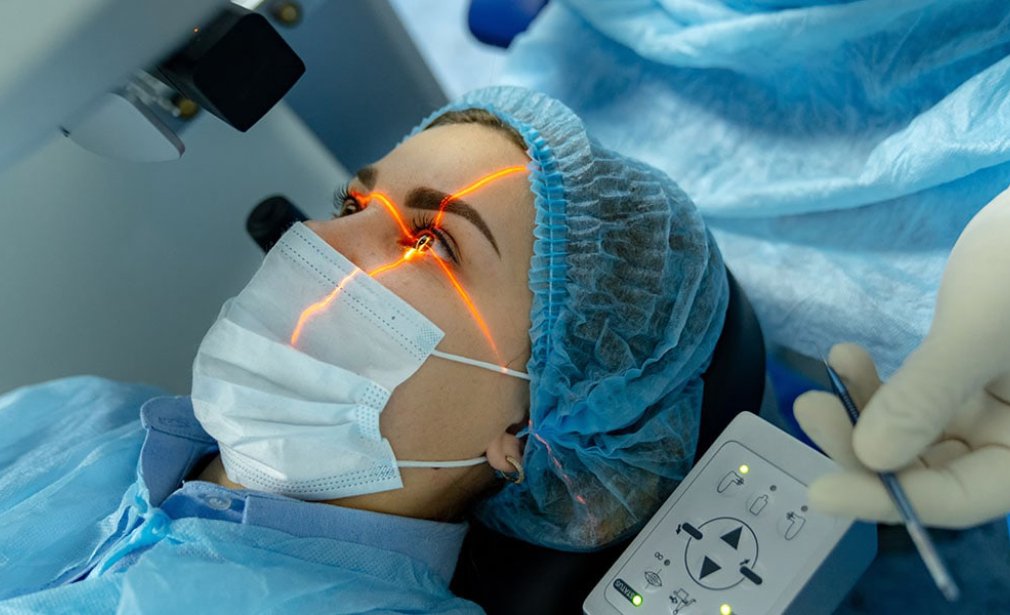LASIK & Refractive Services in Andheri, Mumbai
Laser Vision correction or LASIK is now the most popular procedure worldwide to correct nearsightedness, farsightedness and astigmatism. Its popularity is based on the high rate of patient satisfaction, excellent visual results, quick recovery and the very few side effects and complications.
Not all patients are, however, suitable candidates for LASIK. The good news is that, apart from the very popular Lasik treatment, several other options are also available, including the alternative techniques of Photo Refractive Keratectomy (PRK), implantation of a Phakic intra-ocular lens and a clear lens replacement
What is LASIK?
LASIK stands for Laser Assisted In Situ Keratomileusis and is a surgical procedure that reduces a person’s dependency on glasses or contact lenses by permanently changing the shape of the cornea, the clear covering of the front of the eye, using an excimer laser.
Delivered in short bursts of energy called pulses, the excimer laser is a cool laser that breaks molecular bonds in the corneal tissue a few molecular layers at a time.
For myopia, laser vision correction or refractive surgery involves removing small amounts of corneal tissue to reduce its refractive power, thereby flattens the centre of your cornea so that distant light rays are now focused on the retina.
For hyperopia, your cornea is steepened by removing peripheral tissue to create more refractive power.
If you have astigmatism, the laser smoothens the irregular shape of your cornea to even out its focusing power.
There are currently no proven refractive surgery procedures to treat presbyopia alone, however monovision, one eye for distance and the other eye to read, may be an option.
Vision Problems
The cornea is a part of the eye that helps focus light to create an image on the retina. It works in much the same way that the lens of a camera focuses light to create an image on film. Usually the shape of the cornea and the eye are not perfect and the image on the retina is out-of-focus (blurred) or distorted. These imperfections in the focusing power of the eye are called refractive errors.

Normal

Myopia

Hyperopia

Astigmatism
There are three primary types of refractive errors: Myopia, Hyperopia and Astigmatism.
Persons with myopia, or nearsightedness, have more difficulty seeing distant objects as clearly as near objects.
Persons with hyperopia, or farsightedness, have more difficulty seeing near objects as clearly as distant objects.
Astigmatism is a distortion of the image on the retina caused by irregularities in the cornea or lens of the eye. Combinations of myopia and astigmatism or hyperopia and astigmatism are common.
Types Of LASIK Surgery
Today, there are four main types of LASIK surgery procedures to choose from:
Conventional LASIK corrects your vision based on your prescription for contacts or glasses. Your level of vision correction is determined using the familiar “which is better, this or that?” vision test.
Wavefront optimized LASIK is a newer technology that corrects refractive errors while accounting for both the natural curvature of the eye and the unique characteristics of each individual’s eye. Because this type of LASIK follows the shape of the eye more closely, it has less risk of inducing subtle vision problems, called higher order aberrations, than conventional LASIK.
Femtosecond laser LASIK / Bladeless LASIK it is the latest technology introduced for patients suffering from refractive errors by way of deploying a laser to make a flap on the cornea. The traditional Lasik which used to use a mechanical blade is replaced with a Femtosecond laser making the procedure highly precise and safe.
Contoura Vision LASIK, creates a personalized map of existing higher order aberrations to correct refractive error and these more subtle vision problems. Higher order aberrations may include subtle blurring, less clear visual contrast and even mild glare, halos or starbursts around lights at night.
How LASIK works?
After the eye has been completely numbed using anaesthetic eye drops, the eye is cleaned and eyelid clip is temporarily placed between the lids to prevent blinking. The LASIK procedure consists of 3 main steps:
- A thin flap is created in the surface layer of the cornea and folded to one side.
- The exposed area is then reshaped by very accurately-targeted excimer laser pulses. Complex mathematical algorithms guide the laser to remove microscopic amounts of corneal tissue at pre-determined positions on the cornea to correct its overall curvature. Special eye trackers in the system reassuringly will compensate for involuntary eye movements.
- The flap is then replaced into its original position and re-attaches itself to the cornea over time.
The whole LASIK procedure is completed in about 10 minutes
Since the curvature of the cornea is permanently reshaped, it corrects the refractive error.
Are you a candidate for LASIK?
If you are looking to minimize your dependency on eyeglasses or contact lenses, then you are in good standing to qualify as a candidate for laser vision correction.
You are likely to be a good LASIK candidate if you:
- Are 18 years of age and above(there is no upper age restriction)
- Are not pregnant/breast feeding
- Are free of any chronic eye disease
- Possess stable refractive error
Please check with your doctor on the importance of possessing realistic expectations and understanding of the potential risks and side effects that may occur.
To find out if you are a good candidate for LASIK, please contact Aggarwal EYE Hospital today.
Pre-LASIK Eye Screening
Prior to scheduling Lasik eye surgery, a thorough evaluation of your eyes will be performed to make sure that you qualify for laser eye surgery. Since each set of eyes is unique, there is no way to actually determine your candidacy for laser surgery until you have had your pre-operative evaluation. It involves a series of diagnostic tests, which may include some or all of the following:
- A full review of the overall health of your eyes.
- The measurement of corneal thickness and shape, including corneal topography.
- A complete review of your glasses and contact lens history.
- The measurement of your prescription and refractive error in each eye.
- Dilation of the eyes to check the health of the retina and optic nerve. It also helps to determine the actual absolute power of the eye.
- Custom measurement for higher order aberrations.
- Dry eye test.
- A personal consultation.
During this evaluation, the patient’s visual system is examined with particular attention to issues which could affect a satisfactory outcome or which could increase the patient’s risk to encounter a side effect or complication from the procedure.
In addition, this is the time for the patient to have all questions and concerns addressed.
This process is crucial in determining your suitability and safety for LASIK.
PREPARING FOR YOUR LASIK CONSULTATION
First, you need to schedule a Pre-LASIK screening and your LASIK eye surgery procedure date.
Steps to prepare for your LASIK eye surgery:
- Contact lens wearers: You’ll need to remove your contacts for a period of time prior to the laser vision correction treatment so that your cornea can return to its normal, natural shape.
- Not leaving your contact lenses out long enough for your cornea to assume its natural shape before surgery can have negative consequences which include inaccurate measurements and a poor surgical plan, resulting in poor vision after surgery. If you wear:
soft contact lenses, you should stop wearing them for 2 weeks before your initial evaluation.
toric soft lenses or rigid gas permeable (RGP) lenses, you should stop wearing them for at least 3 weeks before your initial evaluation.
WHAT TO EXPECT AFTER YOUR TREATMENT?
By next day your, uncorrected visual acuity should already be within the level required to drive again (20/40). Most patients are able to resume their normal daily activities within 2 to 4 days.
During the first week your vision will recover rapidly and after 4 weeks your eyes will be close to their optimal visual acuity. It may, however, take 3 months before vision stabilises completely, depending on the initial refractive error. If you fall in the presbyopic age (40 to 45 years and older), you will require reading glasses shortly after surgery.
Some of the restrictions after laser treatment include:
- No mascara or eyeliner for two weeks .
- Extra care should be exercised when bathing and washing hair to avoid unnecessary soap and water in the eye for two weeks.
- No swimming for six weeks.
- No rubbing of the eyes (to ensure that the lamellar flap is not disturbed and stays in place).
You may drive as soon as you feel comfortable to do so. Your night driving vision may take longer to recover than your daytime vision, due to a temporary halo and starburst effect, which you may perceive around lights.
Follow up visits will be scheduled at day one, week one, month 1 and month 3 after the procedure to ensure that your vision and the physical condition of your eyes are recovering as they should.

WHAT CAN YOU EXPECT YOUR EARLY VISION TO BE?
You may typically experience small fluctuations and blurriness in your vision for the first week to a few months as your eyes continue to heal. The time it takes you to heal will depend on the level of nearsightedness, farsightedness and/or astigmatism that was treated. It is common, however, for most patients to see enough to resume their regular activities very quickly.
Frequently asked questions about LASIK
Consectetur adipisicing elit, sed do eiusmod tempor incididunt ut labore et dolore magna aliqua. Ut enim ad minim veniam, quis nostrud laboris nisi ut aliquip ex ea commodo consequat. fugiat nulla pariatur. Nemo enim ipsam voluptatem quia voluptas voluptatem.
When a refractive laser treatment is administered by a qualified, experienced ophthalmologist under sterile conditions, it is very safe and yields excellent results. The procedure has been extensively tested scientifically and clinically. Since its introduction almost 25 years ago, more than 20 million eyes worldwide have been corrected by laser.
All medical procedures have associated risks, which, in the case of laser procedures, are very small providing that the following are adhered to:
| • Your eyes are thoroughly examined beforehand to identify any contra-indications. |
| • The deviations on each eye are accurately measured. |
| • The correct laser procedure is chosen and performed by a skilled and experienced ophthalmologist under sterile conditions. |
| • You co-operate during the procedure. |
| • You faithfully use the prescribed medication afterwards. |
| • You take good care of your eyes, especially during the first two weeks after the procedure. |
The entire surgical procedure takes only 10 minutes or less per eye. The actual amount of time the laser is active on the eye is only one minute or less.
Yes. Following an initial healing period of few months, the effect of the treatment is lifelong.
Most patients will already notice much improved vision without glasses immediately after the procedure. However, the most dramatic improvement is noticed after resting the eye overnight. Most LASIK patients see well the day after their procedure and may resume most of their normal daily activities soon after. But for about two to three weeks your vision may fluctuate.
You can resume your normal activities like reading, computer work, watching television, etc. after the day 1 of treatment. However, continue to protect your eyes from anything that might get into them. Full visual recovery takes approx. 2-3 weeks. Most people will be able to return to normal work on the second day after surgery. Occasionally people may need a longer period off work (fewer than 5%).
Laser treatments will not cause any of these eye problems, nor will it treat them.
Alternatives to Laser Vision Correction
Surface Ablation: PRK (Photorefractive Keratectomy)
PHOTO REFRACTIVE KERATECTOMY
PRK is the acronym for Photo Refractive Keratectomy. It is the first laser vision treatment developed in 1988 to permanently correct vision and today remains the preferred treatment option for patients whose corneas are too thin for Lasik.
PRK differs from other laser treatments in that the treatment is applied directly on the surface of the cornea. The permanently reshaped cornea corrects the refractive error.
Although the initial healing phase is significantly longer, the visual end-result is similar to Lasik.
The first Photo Refractive Keratectomy (PRK) procedure was performed in 1988 and has proven itself to be safe, highly accurate and has yielded excellent results. In certain cases, like marginally thin corneas, PRK is still the preferred method of treatment.
Click on this picture to see an animated illustration of PRK.
Procedure: The epithelial layer on the surface of the cornea is removed whereafter the exposed surface of the cornea is reshaped with an excimer laser. A ‘bandage’ contact lens is placed on the cornea to promote healing. After about 72 hours, when the epithelium has healed, the contact lens is removed.

Since only the epithelial layer on the surface of the cornea is removed, there is minimal structural impact on the cornea. Note the ‘bandage’ contact lens on the cornea.
ADVANTAGES OF PRK
- Since PRK is a surface treatment, the biomechanical integrity of the cornea remains largely intact.
- Due to the simplicity of the technique, PRK is still the most economical option for corneal laser vision correction.
RELATIVE DISADVANTAGES OF PRK
- The recovery period for stable vision is longer compared to other corneal laser techniques, with some discomfort during the first 72 hours.
- Because of the longer recovery time, only one eye is treated at a time, as you will need full use of your other eye while the treated eye heals.
- Vision may fluctuate for up to 3 months, since the healing process of the cornea takes some time. Moreover, the epithelium has to be polished by the continuous blinking action of the eyelids. However, after two weeks most of the healing has occurred and you can expect relatively stable vision thereafter.
- If a further correction is required, it should only be done after 3 months when vision has fully stabilised.
- When the procedure was first introduced in the late 1980s, there was a small risk of scar formation on the cornea if the post-operative instructions were not adhered to. However, due to improved surgical techniques, good aftercare, the use of prescribed eye drops and protection of the eye against harmful UV rays, this risk today is extremely small.
PHAKIC Intraocular lenses or Implantable Collamer Lenses(ICL)

Image formation within the eye mainly occurs by means of the cornea and the crystalline lens. Here, the refractive power of the eye is modified by implanting extra lens power into the eye. ICLs are specialized lenses made of plastic or silicone material, which are implanted into the eye through a small incision without removing the eye’s natural lens
The most popular and successful phakic lens currently available is the STAAR ICL™. Various clinical criteria provide guidelines on the selection of the proper lens for implantation.
A phakic intraocular lens is indicated for those cases where the refractive error is beyond the scope of correction by other modalities.
SCOPE OF CORRECTION:
- Short-sightedness (myopia): up to -25.0 diopter
- Far-sightedness (hyperopia): up to +15.0 diopter
- astigmatism: up to -7.5 diopter
- Combinations of astigmatism and hyperopia/myopia
These refractive errors fall outside the range of laser or other refractive surgeries, as this will result in extremely poor quality of vision.
ADVANTAGES OF PHAKIC LENSES
- In contrast to other refractive techniques, very high degrees of astigmatism, near sightedness and farsightedness can be corrected.
- Suitable for different patients: Since the ICL treatment is completely safe even if you have thin corneas, dry eyes, or large pupils (as it does not involve removing tissue from the cornea), it may be suitable for candidates who are otherwise unfit for Laser vision correction.
- The procedure is fully reversible. The lens may be removed at a later stage, replaced or changed if the prescription changes.
- The cornea, which is the most important refractive component of the eye, remains intact. There are consequently no permanent changes to the actual structure of the eye.
- In the past there was a risk that a cataract could form. New techniques reduced the risk substantially but, should it nevertheless occur, it can be treated.
DISADVANTAGES OF PHAKIC LENSES
- As this is an intraocular procedure, there is a small risk of infection. We do, therefore, take extensive precautions against infection by doing the operation in a sterile environment, and provide detailed instructions for after-care to the patient.
- Due to the mechanics of fluid distribution within the eye, the pressure within the eye may rise shortly after the procedure if the lens is not in perfect position. For this reason, we always keep our patients for an hour or two for observation after the procedure, so that we may react promptly upon any sign of pressure increase. During this time, you may relax in our company, and enjoy a cup of tea and sandwiches, or just doze off after the anaesthetic.
- Phakic lenses are relatively expensive, since these lenses are made to the patient’s prescription.
Refractive Lens Exchange (Clear Lens Extraction)
With refractive lens exchange (RLE) — also called Clear Lens Extraction or CLE — an artificial lens is used to replace your eye’s natural lens in order to improve vision. The procedure is performed much like cataract surgery. This option is also available in selected cases of refractive correction, namely patients with extreme pathological refractive errors.
As is an option in cataract surgery, RLE may employ multifocal or accommodative intraocular lenses (IOLs). These lenses allow the ability to focus at all distances.
The principal disadvantage of replacing the natural lens, is the resultant loss of natural accommodation (the ability to adjust focus). It is therefore mainly employed in cases where patients have already lost their accommodation due to the natural ageing process, namely the presbyopic group of patients older than 40 years.


